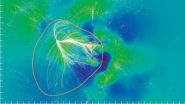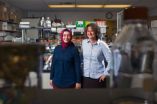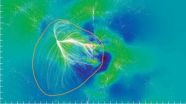(Press-News.org) WHAT:
An NIH-led team of scientists has discovered a new vulnerability in the armor of HIV that a vaccine, other preventive regimen or treatment could exploit. The site straddles two proteins, gp41 and gp120, that jut out of the virus and augments other known places where broadly neutralizing antibodies (bNAbs) bind to HIV. This newly identified site on the viral spike is where a new antibody found by the scientists in an HIV-infected person binds to the virus. Called 35O22, the antibody prevents 62 percent of known HIV strains from infecting cells in the laboratory and is extremely potent, meaning even a relatively small amount of it can neutralize the virus.
Following their discoveries, the scientists found that 35O22-like antibodies were common in a group of HIV-infected people whose blood contained antibodies that potently neutralized a broad array of HIV strains. According to the researchers, this suggests that it might be easier for a vaccine to elicit 35O22 than some other known bNAbs, which are less common.
Since 35O22 binds only to forms of the viral spike that closely resemble those that naturally appear on HIV, the scientists believe a vaccine that elicits 35O22-like antibodies would need to mimic the natural shape of the spike as closely as possible. This would require a different approach than that used in many previous experimental HIV vaccines, which have included just parts of the viral spike rather than a structure that looks like the entire native viral spike.
In addition, the researchers report, the HIV strains that 35O22 neutralizes complement strains neutralized by other bNAbs. This suggests that eliciting or combining 35O22 with a few other bNAbs in a vaccine or a prevention or treatment regimen could likely neutralize the vast majority of HIV strains found around the globe, according to the scientists.
INFORMATION:
ARTICLE:
J Huang et al. Broad and potent HIV-1 neutralization by a human antibody that binds the gp41-120 interface. Nature DOI: 10.1038/nature13601 (2014).
WHO:
Anthony S. Fauci, M.D., director of the National Institute of Allergy and Infectious Diseases, part of NIH, is available for comment. Mark Connors, M.D., chief of the HIV-Specific Immunity Section of the NIAID Laboratory of Immunoregulation and the principal investigator of the study, also is available for interviews.
CONTACT:
To schedule interviews, please contact Laura S. Leifman, (301) 402-1663, laura.sivitz@nih.gov.
NIAID conducts and supports research—at NIH, throughout the United States, and worldwide—to study the causes of infectious and immune-mediated diseases, and to develop better means of preventing, diagnosing and treating these illnesses. News releases, fact sheets and other NIAID-related materials are available on the NIAID Web site at http://www.niaid.nih.gov.
About the National Institutes of Health (NIH):
NIH, the nation's medical research agency, includes 27 Institutes and Centers and is a component of the U.S. Department of Health and Human Services. NIH is the primary federal agency conducting and supporting basic, clinical, and translational medical research, and is investigating the causes, treatments, and cures for both common and rare diseases. For more information about NIH and its programs, visit http://www.nih.gov/.
NIH...Turning Discovery Into Health®
NIH-led scientists discover HIV antibody that binds to novel target on virus
2014-09-03
ELSE PRESS RELEASES FROM THIS DATE:
Hawaii scientist maps, names Laniakea, our home supercluster of galaxies
2014-09-03
University of Hawaii at Manoa astronomer R. Brent Tully, who recently shared the 2014 Gruber Cosmology Prize and the 2014 Victor Ambartsumian International Prize, has led an international team of astronomers in defining the contours of the immense supercluster of galaxies containing our own Milky Way. They have named the supercluster "Laniakea," meaning "immense heaven" in Hawaiian. The paper explaining this work is the cover story of the September 4 issue of the prestigious journal Nature.
Galaxies are not distributed randomly throughout the universe. Instead, they are ...
Sequencing of 5 African fishes reveals diverse molecular mechanisms underlying evolution
2014-09-03
Cambridge, MA. Wed. September 3, 2014 — In an effort to understand the molecular basis of adaptation in vertebrates, researchers sequenced the genomes and transcriptomes of five species of African cichlid fishes. A research team led by scientists at the Broad Institute of MIT and Harvard uncovered a variety of features in the cichlid genomes that enabled the fishes to thrive in new habitats and ecological niches within the Great Lakes of East Africa. In addition to helping explain the complex genomic mechanisms that give rise to incredible diversity among cichlid fishes, ...
Airlock-like transport protein structure discovered
2014-09-03
Palo Alto, CA—Sugars are an essential source of energy for microrganisms, animals and humans. They are produced by plants, which convert energy from sunlight into chemical energy in the form of sugars through photosynthesis.
These sugars are taken up into cells, no matter whether these are bacteria, yeast, human cells or plant cells, by proteins that create sugar-specific pores in the membrane that surrounds a cell. These transport proteins are thus essential in all organisms. It is not surprising that the transporters of humans and plants are very similar since they ...
Carbon stored in the world's soils more vulnerable to climate change than expected
2014-09-03
The response of soil microbial communities to changes in temperature increases the potential for more carbon dioxide to be released from the world's soils as global temperatures rise, scientists have revealed.
The potential for global warming to stimulate decomposition rates in soils, and thus release large quantities of carbon dioxide to the atmosphere, has long been considered to be one of the potentially most important positive feedbacks to climate change. However, the results from more recent studies have suggested that responses within microbial communities could ...
Study shows cellular RNA can template DNA repair in yeast
2014-09-03
The ability to accurately repair DNA damaged by spontaneous errors, oxidation or mutagens is crucial to the survival of cells. This repair is normally accomplished by using an identical or homologous intact sequence of DNA, but scientists have now shown that RNA produced within cells of a common budding yeast can serve as a template for repairing the most devastating DNA damage – a break in both strands of a DNA helix.
Earlier research had shown that synthetic RNA oligonucleotides introduced into cells could help repair DNA breaks, but the new study is believed to be ...
Newly identified galactic supercluster is home to the Milky Way
2014-09-03
Astronomers using the National Science Foundation's Green Bank Telescope (GBT) -- among other telescopes -- have determined that our own Milky Way galaxy is part of a newly identified ginormous supercluster of galaxies, which they have dubbed "Laniakea," which means "immense heaven" in Hawaiian.
This discovery clarifies the boundaries of our galactic neighborhood and establishes previously unrecognized linkages among various galaxy clusters in the local Universe.
"We have finally established the contours that define the supercluster of galaxies we can call home," said ...
Longitudinal study explores white matter damage, cognition after traumatic axonal injury
2014-09-03
Traumatic Axonal Injury is a form of traumatic brain injury that can have detrimental effects on the integrity of the brain's white matter and lead to cognitive impairments. A new study from the Center for BrainHealth at The University of Texas at Dallas investigated white matter damage in the acute and chronic stages of a traumatic axonal injury in an effort to better understand what long-term damage may result.
The study, published online July 21 in the Journal of Neurotrauma, looked at 13 patients ages 16 to 60 with mild to severe brain injuries from the intensive ...
Bariatric surgical center accreditation improves patient survival and postop complications
2014-09-03
CHICAGO (September 3, 2014): Patients who underwent weight loss operations in recent years, when most bariatric surgical centers were accredited, had fewer postoperative complications and were 2.3 times less likely to die in the hospital than patients who had bariatric procedures performed before a national movement toward facility accreditation was taking place, according to new study findings. Study authors, who published their results in the September issue of the Journal of the American College of Surgeons, say these findings suggest that accreditation of bariatric ...
Is a gluten-free diet enough to control the complications of celiac disease?
2014-09-03
New Rochelle, NY, September 2, 2014—A lifelong gluten-free diet (GFD) is the conventional approach to managing celiac disease, a chronic inflammatory disorder affecting the small intestine that can result in malnutrition. However, recent evidence shows that a GFD may not be sufficient to prevent serious complications related to celiac disease. A detailed discussion of the metabolic disorders and functional abnormalities that can develop, and nutritional treatments for these is presented in a Review article published in Journal of Medicinal Food, a peer-reviewed journal ...
Innovative algorithm spots interactions lethal to cancer
2014-09-03
Despite the revolutionary biotechnological advancements of the last few decades, an ideal anti-cancer treatment — one that's immediately lethal to cancer cells, harmless to healthy cells, and resistant to cancer's relapse — is still a dream.
But a concept called "synthetic lethality" holds great promise for researchers. Two genes are considered synthetically lethal when their combined inactivation is lethal to cells, while inhibiting just one of them is not. Synthetic lethality promises to deliver personalized, more effective, and less toxic therapy. If a particular gene ...





